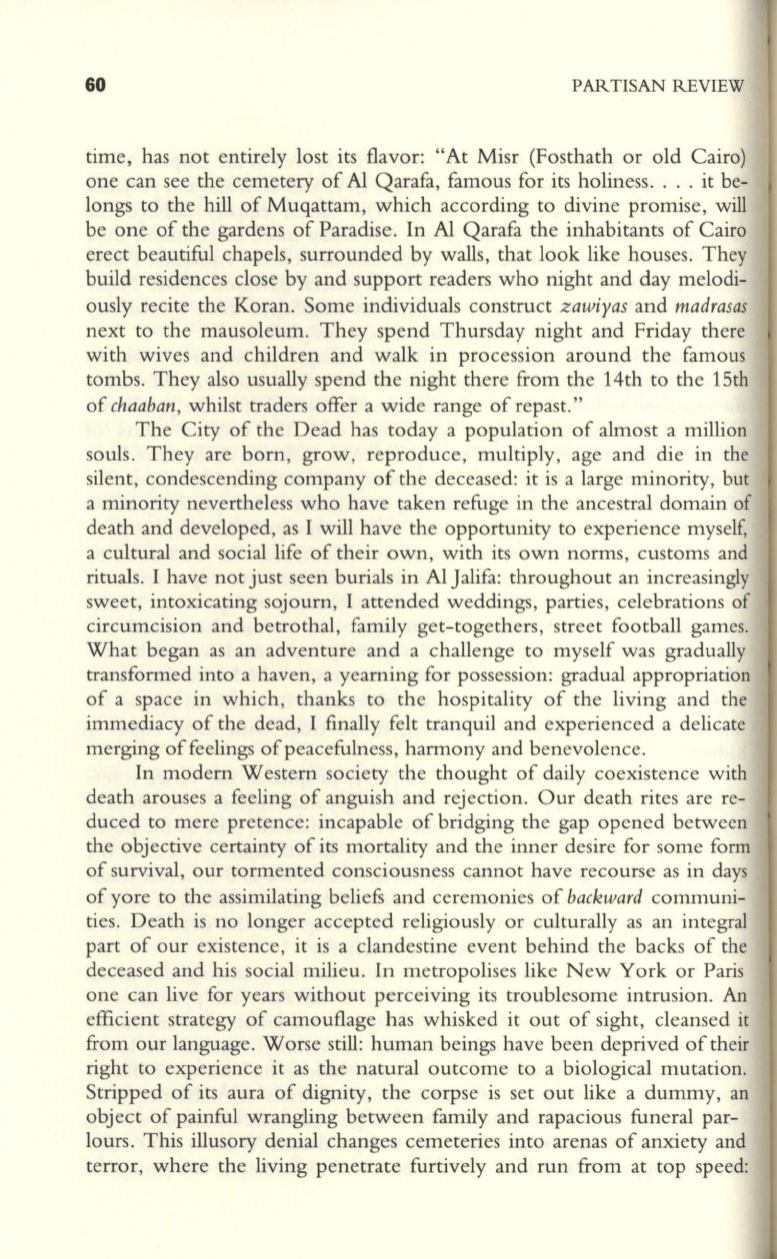
60
PARTISAN REVIEW
time, has not entirely lost its flavor: "At Misr (Fosthath or old Cairo)
one can see the cemetery of AI Qarafa, famous for its holiness.... it be–
longs to the hill of Muqattam, which according to divine promise, will
be one of the gardens of Paradise. In AI Qarafa the inhabitants of Cairo
erect beautiful chapels, surrounded by walls, that look like houses. They
build residences close by and support readers who night and day melodi–
ously recite the Koran. Some individuals construct
zawiyas
and
madrasas
next to the mausoleum. They spend Thursday night and Friday there
with wives and children and walk in procession around the famous
tombs. They also usually spend the night there from the 14th to the 15th
of
chaaban,
whilst traders offer a wide range of repast."
The City of the Dead has today a population of almost a million
souls. They are born, grow, reproduce, multiply, age and die in the
silent, condescending company of the deceased: it is a large minority, but
a minority nevertheless who have taken refuge in the ancestral domain of
death and developed, as I will have the opportunity to experience myself,
a cultural and social life of their own, with its own norms, customs and
rituals. I have not just seen burials in AI Jalifa: throughout an increasingly
sweet, intoxicating sojourn, I attended weddings, parties, celebrations of
circumcision and betrothal, family get-togethers, street football games.
What began as an adventure and a challenge to myself was gradually
transformed into a haven, a yearning for possession: gradual appropriation
of a space in which, thanks to the hospitality of the living and the
immediacy of the dead, I finally felt tranquil and experienced a delicate
merging of feelings of peacefulness, harmony and benevolence.
In modern Western society the thought of daily coexistence with
death arouses a feeling of anguish and rejection. Our death rites are re–
duced to mere pretence: incapable of bridging the gap opened between
the objective certainty of its mortality and the inner desire for some form
of survival, our tormented consciousness cannot have recourse as in days
of yore to the assimilating beliefs and ceremonies of
backward
communi–
ties. Death is no longer accepted religiously or culturally as an integral
part of our existence, it is a clandestine event behind the backs of the
deceased and his social milieu. In metropolises like New York or Paris
one can live for years without perceiving its troublesome intrusion. An
efficient strategy of camouflage has whisked it out of sight, cleansed it
from our language. Worse still: human beings have been deprived of their
right to experience it as the natural outcome to a biological mutation.
Stripped of its aura of dignity, the corpse is set out like a dummy, an
object of painful wrangling between family and rapacious funeral par–
lours. This illusory denial changes cemeteries into arenas of anxiety and
terror, where the living penetrate furtively and run from at top speed:


